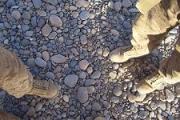I think I agree, if you are saying that being a good shot on the range has almost nothing to do with shooting stressful operational conditions.
Again, I think I agree, but the debate that I have been having for the last 7 years falls around the idea of "basics." The devil is in the detail of the two-steps approachIt is therefore a simple two step process. One, get the basic skills right, then two, apply them in battle simulated conditions.
As concerns basics of step 1, and in no order, my conclusions thus far are:
a.) Be able to group well enough to zero his weapon - 10.1cm -"4 inches" at 100m. - 0.01% of range.
b.) Be able to perform effective magazine changes and clear stoppages.
c.) Be able to clean and maintain his weapon.
d.) Be "safe" under training and operational conditions.
e.) Be able to consistently hit a 1 x 0.5m target at 100m from the standing position (soles of both feet on the ground) - using single aimed shots.
Now, if someone can do that, within 3-4 range days, I'm happy.












Bookmarks